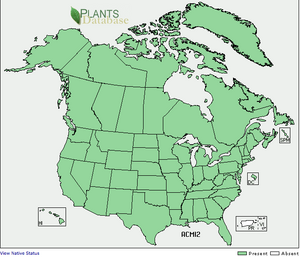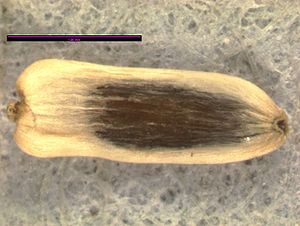Difference between revisions of "Achillea millefolium"
(→Photo Gallery) |
(→Description) (Tag: VisualEditor) |
||
| (57 intermediate revisions by 6 users not shown) | |||
| Line 1: | Line 1: | ||
| − | + | * Scientific Name: ''Achillea'' ''millefolium'' | |
| − | '''''Achillea | + | * Family: Asteraceae |
| + | * Common Names: milfoil, yarrow | ||
| + | * Synonyms/Misapplications: ''Achillea'' ''borealis, Achillea'' ''lanulosa'' | ||
| + | * Codon: ACHMIL | ||
| + | ---- | ||
| + | [[File:ACHMIL1.jpg |thumb|Photo by Ray Izumi, 2009. Also featured on Main Page]] | ||
| − | + | === Taxonomy === | |
| − | + | {{Taxobox | |
| − | + | | image = | |
| − | + | | image_caption = | |
| − | + | | name = | |
| − | + | | regnum = [[Plant]]ae | |
| − | *''Achillea | + | | subregnum = Viridiplantae |
| − | + | | phylum = Tracheophyta | |
| − | *''Achillea | + | | classis = Magnoliopsida |
| − | *''Achillea millefolium | + | | ordo = Asterales |
| − | + | | familia = Asteraceae | |
| − | + | | genus = ''Achillea ''L. | |
| − | *''Achillea | + | | species = '''''Achillea millefolium''' ''L. |
| + | | binomial = | ||
| + | | binomial_authority = | ||
| + | | synonyms = *''Achillea borealis'' Bong. | ||
| + | *''Achillea lanulosa'' Nutt. | ||
| + | *''Achillea millefolium'' ssp. ''borealis'' (Bong.) Breitung | ||
| + | *''Achillea laxiflora'' Pollard & Cockerell | ||
| + | }} | ||
| + | <ref>Integrated Taxonomic Information System. Retrieved from https://www.itis.gov/servlet/SingleRpt/SingleRpt?search_topic=TSN&search_value=35423</ref> | ||
| + | ===Description=== | ||
| + | Herbaceous perennial growing from rhizomes, from one to several stems up to heights 10 dm.<ref name="UW" /> Tripinnate and lance-shaped leaves evenly distributed along stem with the leaves becoming smaller towards the top. Leaves typically between 1/4 inch to 1 1/4 inch wide and 1 1/4 inch long to 6 inches long. Inflorescences flat-topped, containing 10-20 whitish to yellowish,<ref name="USDA">[https://plants.usda.gov/home/plantProfile?symbol=ACMIM5 USDA Plants Profile for Achillea millefolium]</ref> typically radiate pseudanthia.<ref>Hitchcock, C. L., Cronquist, A., Giblin, D., | ||
| + | & Legler, B. et al. (2018). ''Flora of the Pacific Northwest: an | ||
| + | illustrated manual''. Seattle: University of Washington Press, p. 534.</ref> Fruits are achenes.<ref name="UW" /> | ||
| + | ===Bloom Period=== | ||
| + | April-October <ref name="UW">WTU | ||
| + | Herbarium, Burke Museum, & University of Washington. Retrieved from https://biology.burke.washington.edu/herbarium/imagecollection/taxon.php?Taxon=Achillea%20millefolium</ref> | ||
| + | [[File:Screen shot 2012-04-30 at 12.28.51 PM.png|right|300px|Distribution of Yarrow]] | ||
| − | == | + | ===Distribution=== |
| − | + | "Widespread throughout North America" <ref name="USDA" /> | |
| − | + | ===Habitat=== | |
| − | + | Common in open dry to moist areas from high to low elevations; drought tolerant <ref name="UW" /> | |
| − | + | ===Uses=== | |
| − | + | Several tribes of the Plains region of the United States including the Pawnee and Chippewa tribes used common yarrow. The Pawnee used the stalk in a treatment for pain relief. The Chippewa used the leaves in a steam inhalant for headaches. They also chewed the roots and applied the saliva to their appendages as a stimulant. The Cherokee drank a tea of common yarrow to reduce fever and aid in restful sleep. <ref name="USDA" /> | |
| − | + | ||
| − | + | ||
| − | + | ||
| − | + | ||
| − | + | ||
| − | + | ||
| − | + | Herbalist Michael Moore also writes that ''A. millefolium'' is a great benefit for acute fevers as a hot infusion, that it is an effective hemostatic, and that it helps with irritation of the GI mucosa. <ref>Moore, M. (2011). ''Medicinal plants of the Pacific West''. | |
| − | + | Santa Fe: Museum of New Mexico Press.</ref> | |
| − | + | ===Propagation=== | |
| − | + | ||
| − | + | ||
| − | == | + | |
| − | + | ||
| − | + | ||
| − | + | ||
| − | + | ||
| − | + | ||
| − | + | ||
Clean seeds with hammer mill then air screen cleaner. Sow in field between May or June and September. Plant 50-70 seeds per foot 1/2" deep or less spaced in 3" rows. | Clean seeds with hammer mill then air screen cleaner. Sow in field between May or June and September. Plant 50-70 seeds per foot 1/2" deep or less spaced in 3" rows. | ||
| − | ==Seed== | + | ===Seed=== |
| − | [[File:Achillea millefolium single.jpg|300px|thumb | + | [[File:Achillea millefolium single.jpg|300px|thumb|''Achillea millefolium'', photo by Lisa Hintz]] |
| − | |||
'''Seed sample from:''' 2011 | '''Seed sample from:''' 2011 | ||
| Line 67: | Line 72: | ||
'''Longitudinal Cross Section:''' obovate [[File:ACMI-long-crosssection.png]] | '''Longitudinal Cross Section:''' obovate [[File:ACMI-long-crosssection.png]] | ||
| − | |||
| − | |||
| − | |||
| − | |||
| − | |||
| − | + | {{Basics}} | |
| − | + | ||
| − | + | === Photo Gallery === | |
| − | + | <gallery> | |
| − | + | File: ACHMIL2.jpg|Photo: Ben Legler, 2004 | |
| + | File:ACHMIL3.jpg|Photo: Ben Legler, 2004 | ||
| + | </gallery> | ||
| + | ===References=== | ||
| + | <references /> | ||
Latest revision as of 13:27, 24 June 2021
- Scientific Name: Achillea millefolium
- Family: Asteraceae
- Common Names: milfoil, yarrow
- Synonyms/Misapplications: Achillea borealis, Achillea lanulosa
- Codon: ACHMIL
Contents
Taxonomy
| Scientific classification | |
|---|---|
| Kingdom: | Plantae |
| Subkingdom: | Viridiplantae |
| Phylum: | Tracheophyta |
| Class: | Magnoliopsida |
| Order: | Asterales |
| Family: | Asteraceae |
| Genus: | Achillea L. |
| Species: | Achillea millefolium L. |
| Synonyms | |
| |
Description
Herbaceous perennial growing from rhizomes, from one to several stems up to heights 10 dm.[2] Tripinnate and lance-shaped leaves evenly distributed along stem with the leaves becoming smaller towards the top. Leaves typically between 1/4 inch to 1 1/4 inch wide and 1 1/4 inch long to 6 inches long. Inflorescences flat-topped, containing 10-20 whitish to yellowish,[3] typically radiate pseudanthia.[4] Fruits are achenes.[2]
Bloom Period
April-October [2]
Distribution
"Widespread throughout North America" [3]
Habitat
Common in open dry to moist areas from high to low elevations; drought tolerant [2]
Uses
Several tribes of the Plains region of the United States including the Pawnee and Chippewa tribes used common yarrow. The Pawnee used the stalk in a treatment for pain relief. The Chippewa used the leaves in a steam inhalant for headaches. They also chewed the roots and applied the saliva to their appendages as a stimulant. The Cherokee drank a tea of common yarrow to reduce fever and aid in restful sleep. [3]
Herbalist Michael Moore also writes that A. millefolium is a great benefit for acute fevers as a hot infusion, that it is an effective hemostatic, and that it helps with irritation of the GI mucosa. [5]
Propagation
Clean seeds with hammer mill then air screen cleaner. Sow in field between May or June and September. Plant 50-70 seeds per foot 1/2" deep or less spaced in 3" rows.
Seed
Seed sample from: 2011
Average Measurement: 1.9 x 0.6 x 0.3
Measurement Range: L: 1.6 - 2.1, W: 0.5 - 1, D: 0.2 - 0.5
Features
Shape: Seed narrowly winged at margins, thicker in the middle. Seed face is narrower at hilum end, broadening at opposite side.
Color: Seed coat papery and white, becoming transparent at the center to reveal a red-brown inner seed.
Surface: Finely longitudinally ridged.
Latitudinal Cross Section: elliptical ![]()
Longitudinal Cross Section: obovate ![]()
Basic Explanations and Assumptions:
The dimensions for the seeds are length x width x depth. The location of the hilum is used as the base of the seed, and the length is measured from hilum to the opposite apex. Where a style is present, the length is measured from the hilum to the bottom of the style. Width is measured at a right angle to the length at the widest part. Depth is measured at a right angle to the intersection of height and width lines.
Measurements included are the mean average for each measurement of ten separate seeds.
All measurements in millimeters unless otherwise noted.
Photo Gallery
References
- ↑ Integrated Taxonomic Information System. Retrieved from https://www.itis.gov/servlet/SingleRpt/SingleRpt?search_topic=TSN&search_value=35423
- ↑ 2.0 2.1 2.2 2.3 WTU Herbarium, Burke Museum, & University of Washington. Retrieved from https://biology.burke.washington.edu/herbarium/imagecollection/taxon.php?Taxon=Achillea%20millefolium
- ↑ 3.0 3.1 3.2 USDA Plants Profile for Achillea millefolium
- ↑ Hitchcock, C. L., Cronquist, A., Giblin, D., & Legler, B. et al. (2018). Flora of the Pacific Northwest: an illustrated manual. Seattle: University of Washington Press, p. 534.
- ↑ Moore, M. (2011). Medicinal plants of the Pacific West. Santa Fe: Museum of New Mexico Press.





